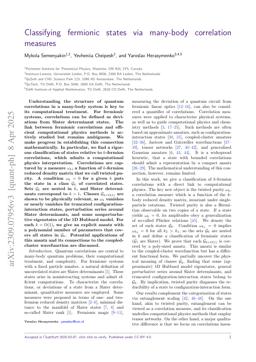2025-04-15
Classifying fermionic states via many-body correlation measures
Publication
Publication
Quantum , Volume 9 p. 1705:1- 1705:18
Understanding the structure of quantum correlations in a many-body system is key to its computational treatment. For fermionic systems, correlations can be defined as deviations from Slater determinant states. The link between fermionic correlations and efficient computational physics methods is actively studied but remains ambiguous. We make progress in establishing this connection mathematically. In particular, we find a rigorous classification of states relative to k-fermion correlations, which admits a computational physics interpretation. Correlations are captured by a measure ωk, a function of k-fermion reduced density matrix that we call twisted purity. A condition ωk = 0 for a given k puts the state in a class Gk of correlated states. Sets Gk are nested in k, and Slater determinants correspond to k = 1. Classes Gk=O(1) are shown to be physically relevant, as ωk vanishes or nearly vanishes for truncated configuration-interaction states, perturbation series around Slater determinants, and some nonperturbative eigenstates of the 1D Hubbard model. For each k = O(1), we give an explicit ansatz with a polynomial number of parameters that covers all states in Gk. Potential applications of this ansatz and its connections to the coupled-cluster wavefunction are discussed.
| Additional Metadata | |
|---|---|
| doi.org/10.22331/q-2025-04-15-1705 | |
| Quantum | |
| Organisation | Centrum Wiskunde & Informatica, Amsterdam (CWI), The Netherlands |
|
Semenyakin, M., Cheipesh, Y., & Herasymenko, Y. (2025). Classifying fermionic states via many-body correlation measures. Quantum, 9, 1705:1–1705:18. doi:10.22331/q-2025-04-15-1705 |
|

